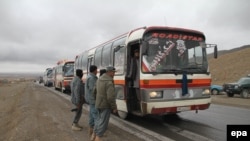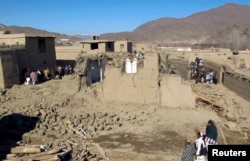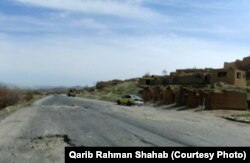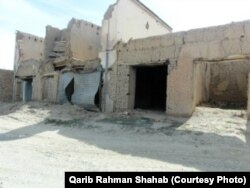WARDAK, Afghanistan -- Locals in the central Afghan province of Wardak have named a small culvert in a remote district of their province the "bloody hump."
The nondescript bridge along the main highway connecting the capital Kabul with the southern city of Kandahar has been the scene of hundreds of Taliban bomb attacks and ambushes.
Piles of burnt vehicles testify to the violence on the bridge over a dry riverbed in Wardak's volatile Sayad Abad district.
Hundreds of soldiers and civilians have lost their lives to the Taliban mines and improvised explosive devices or shootings in the most dangerous stretch of Afghanistan's "Highway of Horrors" as the Kabul–Kandahar Highway is commonly known.
"Around 500 people have been killed at the bloody hump, and as many as 250 have been wounded," says Sharifullah Hotak, a Wardak provincial council member. He says these numbers are based on hospital figures and estimates from local residents.
The spokesman for the Wardak provincial security headquarters, Abdul Wali Nowruzi, cites a similar figure, however, and says the victims are chosen indiscriminately.
"International troops, private security contractors, Afghan National Army (ANA) forces, Afghan National Police (ANP) forces, drivers of supply trucks, civilians and Taliban fighters have been killed in this area," he said.
Nowruzi added that private security guards constitute a large percentage of the casualties. More than 20 Taliban fighters have also been killed while planting mines on the small bridge or as a result of firefights in the nearby area.
Bridge To Nowhere
The primary task of the private security contractors was to ensure safe passage for supply convoys bringing goods to international and Afghan security forces stationed in the region.
Afghan National Security Forces have taken over security duties at the dangerous spot, and a permanent police checkpoint is now stationed 100 meters from the culvert.
Yet the recently erected police checkpoint has failed to prevent further attacks, says another Wardak provincial council member, who preferred not to be named.
"There are two reasons for this: The police either had connections with the Taliban or they did not properly monitor the area for unknown reasons," the councilor said.
Taliban's Favorite Blind Corner
The "bloody hump" is one of many points on the highway targeted by local Taliban in the volatile district of Sayad Abad, but its strategic position has made it the site of more than 200 attacks in eight years, according to local residents.
Situated on a blind corner, the hidden bridge -- only 3 meters wide and 7 meters long -- provides perfect cover for Taliban assailants.
On one side of the culvert lies the busy Salar Bazar market, which provides a screen, while the lush green farms and trees on the other side of the road ensure Taliban fighters can escape and get to the nearby village unspotted.
"The bloody hump is located in a spot on the highway where further down the road there are green and dense trees and farms, and on the upper side of the road there is the village of Salar, which means that the only way to commute through here is the highway," says a local elder from Salar Village, Modeer Shir Agha.
"If the road is damaged, cars cannot go over to the village or lower down to the farmlands," he said. "This is where the Taliban seize the opportunity and target the vehicle ahead, which inevitably damages the road ... then they start a firefight."
In one example from 2013, a commuter bus was attacked and 33 civilians and private security contractors were killed.
Purported Taliban spokesman Zabihullah Mujahid said he does not know the precise number of people killed on the Sayad Abad river-crossing, but that "it is a lot."
Farmers Fleeing
The high number of attacks on the bridge has decimated the local economy by incurring millions of dollars in losses in the remote impoverished region.
Meat packers at the Salar Bazar say they now only do 10 percent as much business as previously.
Farmers in the area below the culvert have been forced to abandon their land because the assailants run detonation chords across their fields.
Acting Wardak Governor Abdul Abdul Majid Khogyani declined to offer an official figure for the number of casualties at the Sayad Abad culvert but says there has been no "major security incident" on the Kabul–Kandahar Highway in the past eight months.
On March 24, however, an armed group killed 13 passengers in an attack on a bus in Sayad Abad at night.
The "bloody hump" culvert at least has been free of attacks since early March, and the government has reconstructed it once again.
More than 50 mines have been cleared from the site with the assistance of international forces, but with the return of warmer weather and the Taliban’s annual spring offensive, local residents expect more explosions soon.
as/fg









